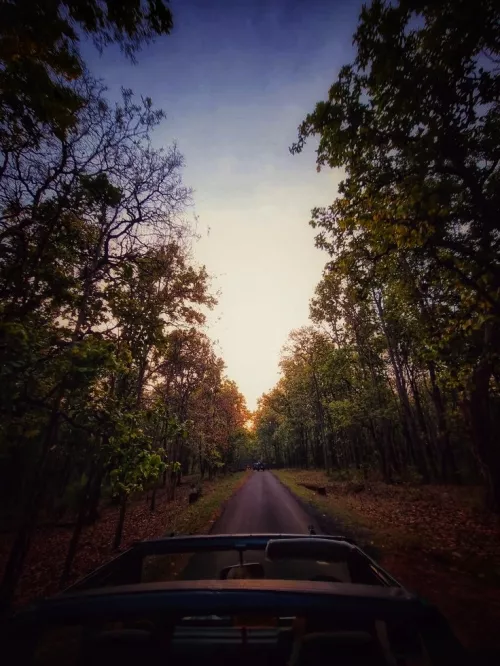
As dawn broke, I was gently stirred by the serene sounds of nature surrounding me. The soft rustle of leaves and the distant call of a red-wattled lapwing welcomed the new day. I opened my eyes to find the morning mist slowly lifting, revealing a world in vibrant greens and rich earth tones—a lush forest awakening to the sun's warm embrace.
This was my week at Kanha Tiger Reserve (KTR), nestled in the heart of India, a stunning showcase of natural beauty. Its landscapes are a harmonious blend of dense Sal forests, sprawling meadows, and serene water bodies. The vibrant hues of wildflowers and the golden grasslands stretch as far as the eye can see. Teak trees stand tall, providing a canopy that filters sunlight into a speckled glow on the forest floor. The reserve's rolling hills and streams create a picturesque setting that is both peaceful and awe-inspiring.
With each new day, I moved deeper into the reserve, my heart racing with anticipation. The thrill of spotting the cat in its natural habitat or hearing the playful chatter of monkeys above but as I settled back into my cosy lodge, with the warm scent of freshly brewed coffee I would gaze out at the sprawling forest, with drifting thoughts back to the engaging conversations I had shared with the local guides and residents.
Their stories painted vivid pictures of the land—tales of ancient trails, hidden waterfalls, and the wildlife that roamed the shadows of the trees. Each encounter had left a mark on me, a deeper understanding of the life and culture that thrived in the woods, the delicate balance that exists between man and nature. This balance, however, is often tested, leading to conflicts that echo through the ages.
The Silent Struggle
Farmers from the nearby villages have always lived in harmony with the forest. The small plots of land, on the fringes of the park, provide just enough to sustain the families. But as the seasons change, so do the challenges. Summers, when the rains are sparse, and the crops struggle to grow the forest, too, feels the strain, and its inhabitants begin to course closer to human settlements in search of food.
I could imagine the commotion listening to the story of Balwan the tiger that had just ventured out of the buffer zone, the frantic mooing of the cows, the chill down the spines of the villagers to find the cat, its eyes glowing in the darkness, prowling near. The majestic beast, driven by hunger has strayed from its territory.
As I continued I couldn’t help but feel the weight of the conflict that loomed over them. The risks of confronting a dangerous creature are daunting and the profound loss villagers would face if their cattle were harmed—devastation that would ripple through the fabric of their lives.
I watched as the locals gathered at a chai ki tapri during my evening walks, their faces alight with fear and resolve. They exchanged ideas, debating the best course of action. Some passionately spoke about constructing stronger fences, believing that fortifications would keep them safe. Others, however, suggested turning to the forest department for assistance, hoping for a solution that wouldn’t put them at further risk.
As someone who has worked closely with ecosystem dynamics, I felt a deep sense of empathy for them. They were caught in a struggle between respecting the tiger's right to exist and the pressing need to safeguard their livelihoods. It was a delicate balance, one that weighed heavily on them all, and I couldn't help but ponder how this dilemma reflected the broader struggles between nature and humanity.
The forest department, aware of the situation, has set up camera traps and increased patrolling. They have initiated awareness programs, teaching villagers how to coexist with wildlife. Back in the village, life might slowly return to normal. However, the deeper question is how I work towards these challenges as the forest and its inhabitants are not adversaries but part of a shared world.
The Ecologist's Dilemma
As I sat on the patio, a gentle breeze drifted through the air, bringing with it the soothing chimes of bells mingled with the distant sounds of cows grazing peacefully. It was a symphony that wrapped around me, serene and comforting.
Yet, amidst the beauty of the moment, questions lingered in my mind. I couldn't shake the feeling that there was something unresolved, something that tugged my thoughts about the increasing frequency of man-animal conflicts. In the nearby village, farmers had reported sighting of the cat. I pondered over the root causes of the conflict. What is that drove the cat into the fields? Is it the lure of easy food? I knew that finding the answers required more than just scientific data; it required understanding the needs and fears of both the villagers and the wildlife.
The real challenge is in effectively implementing the solutions that are frequently discussed in our daily meetings where polished individuals often address various issues, bringing their academic credentials into the conversation. However, it is crucial to not only consider these solutions theoretically but also to ensure they are practical, feasible, and sustainable over the long term. This requires careful planning, resources, and ongoing evaluation to adapt to any unforeseen challenges that may arise as we move forward.
My mind was still buzzing with questions. How could we ensure that the Tiger’s natural habitat will be preserved? What role did climate change play in altering the animal behaviour? And most importantly, how could we foster a sense of coexistence between humans and wildlife?
I know that I don’t have all the answers. But I also know that by working together, we could find a way to coexist and as an ecologist, my role would not just suffice by studying the environment, but also to be a bridge between science and society, helping to create a world where both humans and animals could thrive.
🌻
Dr.D